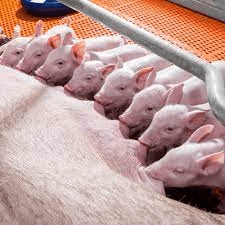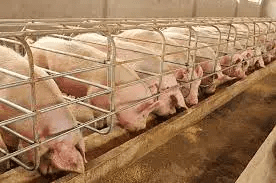Farmers today let’s share about inbreeding, one of the commonest vices in pig farming. Inbreeding is the mating animals of the same breed that are closely related.
Inbreeding is the mating of individuals that are related. In the strict sense, all members of a breed are related. As a result, any seedstock producer is practicing some inbreeding.
Therefore, we generally reserve the term inbreeding for the mating of animals that are more closely related than the average of the breed.
This usually happens to farmers when starting up farms , they have tendencies of buying pigs in pairs not putting it in mind if this pair could be closely related.
The other farmers tend to chose good looking males from a given given furrow and push it to becoming the king of the farm and this bore ends up mating the mother and its sisters.
First before we proceed, let’s understand some of the pig mating system terms in order to fully be carried along as we move forward for better understanding;
Pig Breeding Systems
A breed is defined as a group of animals sharing a common ancestry that have distinguishable, fixed characteristics who when mated with a member of the same breed will produce offspring with the same characteristics (Damron, 2013).
Breeding or mating systems are the approach taken to pairing individuals for breeding in order to incorporate or maintain desired traits.
The five basic pig breeding systems include the following;
1. Inbreeding – breeding individuals who are very closely related within the breed. This is the type of pig breeding system we are currently discussing about in this article.
2. Linebreeding – a form of inbreeding which attempts to concentrate the inheritance of one ancestor or line of ancestors within a herd.
3. Outcrossing – breeding individuals that are less closely related within the breed.
4. Random mating within a breed – mating individuals within a breed without considering their pedigree.
5. Crossbreeding – a planned approach to mating pigs of very different genetic backgrounds which typically results in heterosis. Heterosis is the improved performance of offspring compared to the average of their parents.
Effects of Inbreeding
. There is high concentration of common gens for both desirable and undesirable traits i.e: hernia and cryptorchidism .
. There is decrease in litter size
. Increase in mortality
. Low immunity in pigs
. Weak and slow growing pigs
. Low libido for inbreeding sows and bores
. Few eggs during oestrus for gilts hence furrowing small litter
Read Also: Types of Pig Feed and When to Feed Each
Why does inbreeding matter?

Passing on undesirable traits to the next generation is directly linked to breeding. The more closely related the parents are, the more frequently these undesirable traits will become phenotypic (result in visible impacts on the pig’s health and productivity).
Line breeding uses the same principles as inbreeding but a desired characteristic is being sought. For most breeders, genetic diversity is the key to producing healthy litters and robust examples of future breeding stock. This isn’t simple when the genetic pool to pick from is small, but it is important.
Fortunately, with modern technology, not only can you find out how related one pedigree pig is to another, you can also use artificial insemination from unrelated boars to assist you in lowering the risk.
A mistake some breeders make is registering multiple boars from the same litter to use as sires. One boar should be the maximum from each litter or you risk producing lots of boars used in others breeding programmes, pushing up the number of litters that are closely-related and thereby failing to expand genetic diversity.
Use different, unrelated AI boars each time you breed. Remember that other breeders will be using those AI boars on their own farms, making some of your herd closely related to others around the country. AI stations do change their boars or add new ones to the list, so take advantage of new genetics.
It is recommended for breed conservation that one individual male should not contribute to more than five percent of future breeding populations therefore it is wise to avoid the most popular AI boar.
Uses of Inbreeding
Inbreeding can have several benefits to a seedstock producer if the breeder understands how to monitor it and is willing to sacrifice some performance in the process. Inbreeding tends to subdivide a breed into families that can be identified and crossed with some small benefit.
Creation of families is unlikely to contribute to genetic improvement but may aid in merchandising if other members of the family have done well. Certain families may demonstrate superior performance, but if a family group has poor average performance, it should be discarded quickly.
Inbreeding also promotes an increase in prepotency which is the ability of an individual to consistently pass on its characteristics. This prepotency results from the increase in homozygosity.
Since an inbred individual will have more homozygous gene pairs than a non-inbred individual, there are fewer possible gene combinations for the sperm or egg cells. As a result the offspring should be more similar to each other.
The Co-efficient of inbreeding
In the USA you will often see a pig’s co-efficient of inbreeding (CI) quoted as a percentage and in the UK it is scored as a value between 0 and 0.1. The CI is the probability that a pig with two identical genes received both genes from one parent, and not implicitly that an individual did actually inherit that identical gene.
The more related the mated pigs are, the more likely they will have identical inherited genes (see Table 1). The CI gives a guide as to how related a pig’s parents were to each other and this can be used prior to a mating to calculate the percentage of inbreeding any subsequent piglets would have.
The lower the score of inbreeding, the more likely the piglets will be healthy. As piglets in a litter are not clonal (unless identical twins) and all genes are donated randomly from each parent, CI scores can only be used as a guide and not an absolute.
CI scores are a useful additional tool to use when selecting between equally suitable boars and sows for breeding. It is important to determine any potential of unseen health problems such as sub-fertility and congenital abnormalities appearing in offspring.
Read Also: Business Opportunities in Pig Farming around the World
Changing your Breeding herd CI scores

If you begin to establish greater degrees of ancestral inbreeding – especially if the same common ancestors are shared more than once and on both paternal and maternal sides – the probability of inheriting identical genes increases and therefore the CI score starts to rise considerably.
The impact of recent inbreeding (in the previous two to four generations) is greater than early inbreeding followed by outbreeding. Outbreeding can be used to re-establish genetic diversity in your herds by selecting completely unrelated sows and boars that will produce the lowest CI score in subsequent litters.
Breeders should aim for the lowest CI possible in the subsequent piglets when selecting the parents but accept that it may take a few generations to get down to lower levels.
Various mating schemes of animals are classified under two broad categories namely; inbreeding and outbreeding. This classification depends on the closeness of the biological relationship between mates. Within each category, a wide variation in intensity of this relationship exists. A very fine line separates the two categories.
Mating closely related animals (for example, parent and offspring, full brother and sister or half brother and sister) is inbreeding. With less closely related animals (first cousins, second cousins), people disagree about where to draw the line between inbreeding and outbreeding.
Technically, inbreeding is defined as the mating of animals more closely related than the average relationship within the breed or population concerned. Matings between animals less closely related than this, then, would constitute outbreeding.
Biological Relationships between Animals for Inbreeding
Individual animals are considered to be biologically related when they have one or more common ancestors. For practical purposes, if two individuals have no common ancestor within the last five or six generations, they are considered unrelated.
Biological relationship is important in animal breeding for instance in pig farming because the closer the relationship, the higher the percentage of like genes the two individuals carry. Closeness of relationship is determined by three factors:
- How far back in the two animals’ pedigrees the common ancestor appears
- How many common ancestors they have
- How frequently the common ancestors appear. It is also influenced by any inbreeding of the common ancestor or ancestors
Inbreeding Depression in Swine
Inbreeding depression is the decline in performance that is associated with inbreeding. Since inbreeding depression and heterosis from crossbreeding are essentially opposite effects, it is not surprising that the same traits that respond well to crossbreeding will respond adversely to inbreeding. These would include reproductive traits such as libido in boars, litter size, and weight and survival rate.
Growth rate is also affected by inbreeding. Data from the inbreeding studies in the United States were pooled to evaluate the magnitude of inbreeding depression in swine (Bereskin et al., 1968). Inbreeding of both the pigs and the dam have a substantial negative effect on litter size, pig weight and growth to 154 days.
The inbreeding of the boar had little effect on litter size or pig weight in these studies. Other research indicated that boars from highly inbred lines had more problems with lack of libido and delayed puberty than less inbred boars (Hauser et al., 1952, Missouri Agr. Exp. Sta. Res. Bull. 503).
Read Also: List of Problems Confronting Livestock Production

Good article. I definitely appreciate this site. Continue the good work!
Thank you so much and we are glad that you find our article very helpful